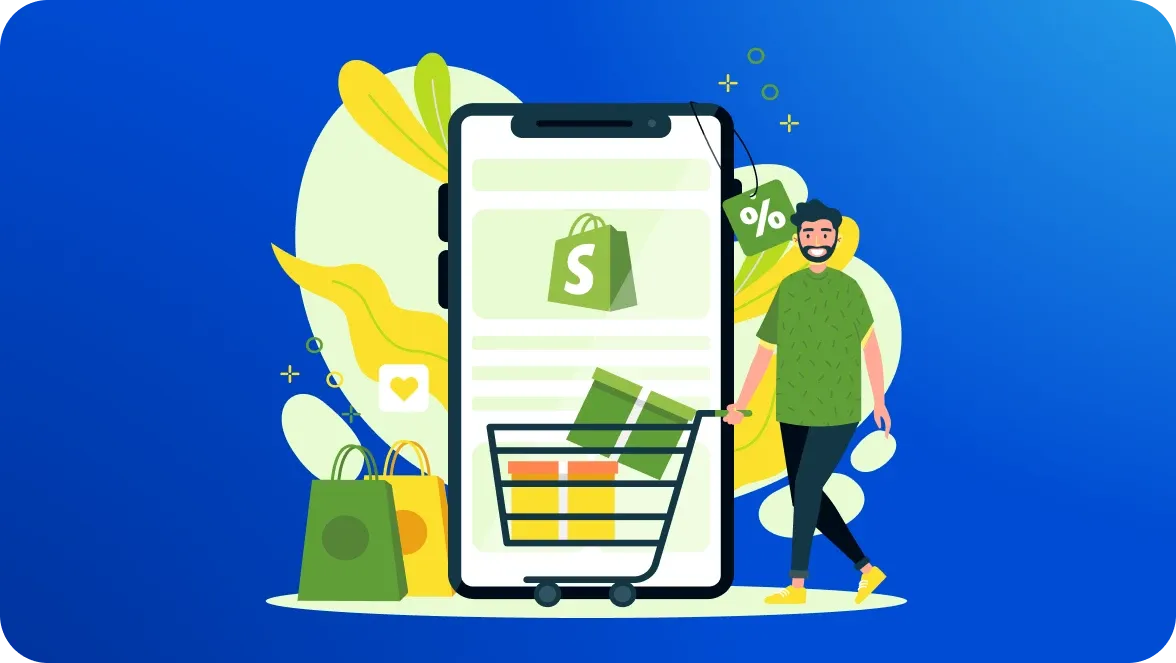
What makes a person choose a specific store for online shopping? Think about your own experience. Are there stores where you buy something repeatedly? What makes you return – low prices, extensive selection, good customer service, nice UX, or something else? Is it a single factor or a combination of things that defines a positive experience for you?
If your store sells exclusive items, it’ll be easy to attract new shoppers – for obvious reasons. If not, you need to find a way to make customers return. It may seem it doesn’t matter whether your customers are new or returning as long as they shop in your online store. Yet, businesses drive around eighty percent of value by re-engaging existing customers.

The DigitalSuits team helps handle this and other challenges. We’ve been developing Shopify stores for around a decade. In this article, our team shares some of the insights into improving customer retention gained over the years. Ten proven practices will help you build stronger customer engagement and enhance business performance.
Factors impacting customer retention
To implement the right strategies to improve customer retention, you need to know what factors impact it. They aren’t limited to marketing, business planning, or technical aspects. It can be a single thing or a combination of unexpected pitfalls interfering with the store’s performance. The most common ones are:
Slow loading times. Customers expect quick access to products, information, and store functionality. Slow websites are frustrating and increase bounce rates.
Complex navigation. Users tend to abandon websites that are difficult to use without buying anything.
Non-responsive design. If a store doesn’t work properly on specific types of devices, making a purchase may be complicated or impossible for their owners.
Inaccurate product descriptions. Customers rely on product details to make decisions. Inaccuracies destroy trust.
Lack of personalization. A lack of basic personalization makes the shopping experience feel generic.
Poor order fulfillment. Delays, delivering wrong items or damaged products, and lacking update notifications don’t do your brand a favor.
Poor customer service. Unresponsive or unhelpful customer service leaves a negative impression. Users expect their issues to be solved promptly and effectively. As for communication, it should be polite by default.
Hidden costs. Extra shipping fees, taxes, and other commissions reduce the likelihood of completing a purchase.
Complicated checkout. Users don’t want to go through complex checkouts. They expect to take minimum steps and share minimum data.
Complicated return process. Returns are a regular practice in online shopping. A problematic return procedure can also deter people from buying.
Security concerns. Doubts about personal data privacy and security cause a lack of trust and a reluctance to interact with a brand.
Retention issues can arise at different stages of the buyer’s journey. Some find difficulties using the website and leave before converting. Others don’t enjoy the experience they receive. They leave as one-time customers who prefer to shop elsewhere next time.
We’d say these problems fall under one of the three categories. To a user, the store and the brand it represents feel:
unhelpful
unfriendly
unfair.
All factors that can trigger these feelings impact customer retention negatively.
Key customer retention metrics
Before learning how to increase customer retention, let’s check how to measure it. Retention metrics let you understand how well your ecommerce business retains customers. What’s more important, they highlight where you can do better. If you aren’t tracking any of these metrics yet, start with these five:
Customer Retention Rate
Customer Churn Rate
Customer Lifetime Value
Average Order Value
Purchase Frequency.
Below, you will find a brief explanation and formula for each.
Customer Retention Rate (CRR)
CRR shows how many customers stay over a specific period. There’s no single acceptable number for a good Shopify returning customer rate, as it varies depending on the goods you sell and business type.
Let’s say you started with 60 customers, gained 20 new ones, and ended with 70 customers. The retention rate would be ( (70−20) ÷ 60) × 100=83%.
Customer Churn Rate (CCR)
CCR is the percentage of customers you lose over a set period. Again, there are no defining statistics on a reasonable Shopify churn rate. The average churn rate in consumer goods and retail is 6.5%. The lower the percentage, the better your online store is doing.
For example, you start with 90 customers. Five of them choose not to return for repeated purchases. The churn rate would be (5 ÷ 90) × 100=5.6%.
Customer Lifetime Value (CLV)
This number shows how much revenue a single customer generates for you. It considers the entire relationship with your business. Calculating CLV is vital for long-term planning and profitability. It defines how much you can spend on acquiring and retaining customers. The higher the CLV is, the more you can afford to pay.
Suppose a customer spends $50 per order. They buy something in your store three times a year for five years. Their CLV would be 50 × 3 × 5 = $750.
Average Order Value (AOV)
AOV shows how much each order is worth. Increasing AOV is aimed at achieving higher revenue per transaction. It’s possible to encourage users with different checks to buy extra items through upselling, cross-selling, and offering bundled products.
Imagine your total monthly revenue is $10,000, which comes from 200 orders. In this case, your AOV would be 10,000/200 = $50.
Purchase frequency (PF)
PF is probably the easiest to understand and calculate. It shows how often an average user shops in your store. A higher purchase frequency indicates that you have a loyal audience. Strive to increase this number using loyalty programs and targeted marketing.
Suppose you have 3000 orders in a year and 100 unique customers. Then, your store’s PF would be 3000/1000 = 3.
Ten proven ecommerce customer retention strategies
How to increase customer retention rate? Customer retention techniques entail a variety of approaches. “Proven” means that these strategies are widely used and can be effective. However, it’s essential to start with the right one.
Before you start getting familiar with these solutions, remember these three things:
- Client retention strategies always work in combination.
- Begin changes by implementing the one that solves your most critical problem.
- Strengthen it with other relevant strategies, putting them into action later.
Now, let’s figure out what can help you retain customers and how to use it.
Personalize the shopping experience
More than half of marketers worldwide admit that personalization drives brand engagement. Nowadays, it’s possible to tailor the shopping journey to each customer. If you consider their preferences and behaviors, you can create a more satisfying experience. The most effective customization approaches are:
product recommendations based on previous purchases and browsing history
personalized email marketing – follow-ups, birthday offers, etc.
dynamic content that adjusts to a website visitor
loyalty programs, engagement bonuses, and exclusive offers.
These and similar strategies show customers that you appreciate them rather than simply considering them as another sale opportunity.
Implement a loyalty program
Loyalty programs are a sure way to encourage buyers to return. You basically reward each purchase with points. Over time, customers can redeem these points, exchanging them for discounts, free products, and other perks.
Numerous Shopify apps allow you to set up a loyalty program. The main thing is to rely on the data about purchasing patterns. They will let you choose the optimal logic. For example, you can set up general cashback, offer double points on items a user buys most frequently, or come up with another idea.
Optimize customer service
Good customer service is also among ecommerce retention strategies. It’s important to interact with your shoppers in a way that will encourage them to come back. Customer service can be an advantage that pushes to buy from stores that offer even slightly higher prices.
Shopify’s built-in customer support features include:
live chat
email support
order status updates
help center.
Merchants can use additional helpdesk apps, like Gorgias or Zendesk, to extend Shopify’s default functionality. Such integrations enable ticket management, automated responses, detailed analytics, and more.
Invest in email marketing and automation
Timely and relevant emails keep customers engaged and can significantly boost the Shopify retention rate. One such example is informing them about products being back in stock. Forty-five percent of users in Australia, the UK, and the US say this simple reminder makes them feel like a brand knows them.
Shopify integrates with emailing solutions like Klaviyo and Mailchimp. With their help, you can create targeted campaigns based on customer behavior and preferences. There’s a lot to include in this communication apart from product reminders. You can use recommendations, special offers, limited discounts, and updates.
Meanwhile, automation enables consistent communication. It’s enough to set up follow-up emails for main interactions once and stop worrying about making mistakes in each upcoming letter. Just remember to update them occasionally, adjusting to different customer segments and trends.
Offer subscription services
Subscription is also on the list of online customer retention strategies. It helps create a predictable revenue stream and keeps customers engaged with your brand over the long term.
Subscriptions can be applied to a variety of products – consumables, clothes, toys, and almost anything else. Shopify apps, such as Recharge Subscriptions and Bold Subscriptions, make it easy to set up offerings. Here, you can choose the logic, set up plans and recurring billing, and manage subscriptions.
Collect and act on customer feedback
Listen to your customers. Based on their feedback, you can improve your assortment and services. To get enough insights, you can:
send out post-purchase surveys and questionnaires
display website pop-up surveys
reach out through live chats and chatbots
monitor social media, online communities, and forums
use Shopify’s built-in tools and extensions for advanced analytics.
It’ll help you identify common interests and issues. Addressing them will improve CX and show that you value their opinions. Long story short, it’s a positive experience that fosters trust and helps increase customer retention.
Simplify the checkout process
Twenty-two percent of shoppers abandon their carts when they find checkout too long or complicated. Now, look at this number from a business performance perspective. Your retention will suffer if the checkout isn’t designed well.
Shopify’s default checkout is user-friendly. Still, you can analyze the step-by-step process. See if there are some fields you can mark as optional. Also, make sure there’s a guest checkout available.
Other strategies to simplify checkout with Shopify include:
one-page checkout
auto-filling in the default fields (name, address, etc.)
the ability to save customer information (including several addresses)
multiple payment options (cards, PayPal, Apple Pay, and Google Pay).
It may seem like a tiny thing to do. Yet, this convenience encourages repeated purchases.
Provide fast and reliable shipping
Offer your customers maximum shipping options. This also lets you increase retention rates. It’s essential to have standard, expedited, and even same-day delivery options. Even if the latter works only in chosen areas, users will appreciate having this choice.
Shopify integrates with shipping providers, making it possible to display accurate shipping costs. Businesses that send out products themselves can use Shopify’s shipping label features. There are also helpful shipping integrations for easier management.
Order fulfillment extensions can enhance reliability. They provide insights into warehousing, packing, and shipping. Hence, you have a full view of the logistics and can arrange it as best as possible.
Run retargeting campaigns
Retargeting helps you reconnect with your store’s visitors who haven’t completed a purchase. The right message can encourage their return and improve customer retention. Don’t be too demanding or pushy. Focus on the advantages they can get.
Online ads are the first choice for retargeting campaigns. Shopify integrates with Facebook, Instagram, and Google. It also has some built-in customization features. You can show users the item they were viewing but didn’t buy. You can also use dynamic ads and automate retargeting campaigns with Shopify’s tools.
Use data analytics to improve retention
Shopify provides excellent tools to help you understand customer data. Analyze shopping behavior, preferences, and trends. Together, they highlight your strengths and weaknesses. If you focus on the latter, you can fix everything that currently interferes with user retention.
Analytics enables customer segmentation, which you need to define your strategies. It’s unlikely that a single approach will meet the needs of all your customers. However, you can group the audience based on their purchasing behavior, location, or other criteria. It’ll be easier to find the right approach for each group.
To wrap up
So, how to improve customer retention? Applying a mix of the strategies above will help you strengthen your business. You make your Shopify store more user-friendly. Customer support becomes more responsive and professional. Marketing gets better tailored to user needs and more effective.
However, putting customer retention strategies into practice may seem daunting. Remember that you don’t have to figure everything out on your own. There are Shopify development teams that will gladly help you — such as DigitalSuits. Schedule an online meeting to discuss your challenges and potential solutions. Let’s make your Shopify store better at retaining customers.







































Was this helpful?
0
No comments yet